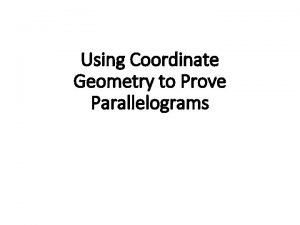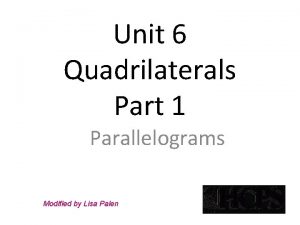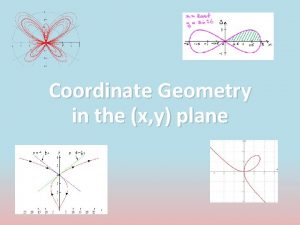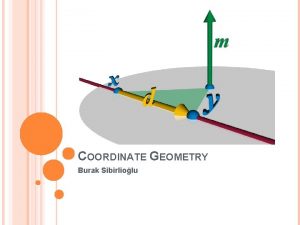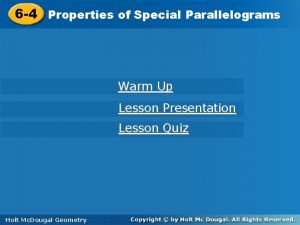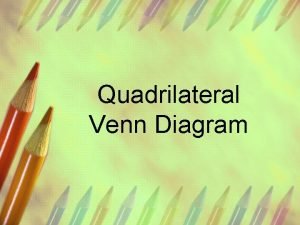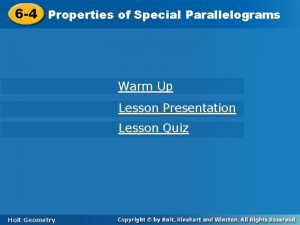Using Coordinate Geometry to Prove Parallelograms Using Coordinate











- Slides: 11

Using Coordinate Geometry to Prove Parallelograms

Using Coordinate Geometry to Prove Parallelograms Definition of Parallelogram Both Pairs of Opposite Sides Congruent One Pair of Opposite Sides Both Parallel and Congruent Diagonals Bisect Each Other


Definition of a Parallelogram Use Coordinate Geometry to show that quadrilateral ABCD is a parallelogram given the vertices A(0, 0 ), B B(2, 6), C (5, 7) and D(3, 1). I need to show that both pairs of opposite sides are parallel by showing that their slopes are equal. A C D

Definition of a Parallelogram Use Coordinate Geometry to show that quadrilateral ABCD is a parallelogram given the vertices A(0, 0 ), B B(2, 6), C (5, 7) and D(3, 1). AB: m = 6 – 0 = 6 = 3 2– 0 2 AB ll CD CD: m = 1 – 7 = - 6 = 3 3– 5 -2 BC: m = 7 – 6 = 1 5– 2 3 AD: m = 1 – 0 = 1 3– 0 3 A C D ABCD is a Parallelogram by Definition BC ll AD

Both Pairs of Opposite Sides Congruent Use Coordinate Geometry to show that quadrilateral ABCD is a parallelogram given the vertices A(0, 0 ), B(2, 6), C (5, 7) and D(3, 1). C B I need to show that both pairs of opposite sides are congruent by using the distance formula to find their lengths. A D

Both Pairs of Opposite Sides Congruent A Use Coordinate Geometry to show that quadrilateral ABCD is a parallelogram given the vertices A(0, 0 ), B(2, 6), C (5, 7) and D(3, 1). AB = (2 – 0)2 + (6 – 0)2 CD = (3 – 5)2 + (1 – 7)2 = 4 + 36 = 40 AB CD BC = (5 – 2)2 + (7 – 6)2 = 9 + 1 = 10 C B D = 4 + 36 = 40 AD = (3 – 0)2 + (1 – 0)2 = 9 + 1 = 10 BC AD ABCD is a Parallelogram because both pair of opposite sides are congruent.

One Pair of Opposite Sides Both Parallel and Congruent Use Coordinate Geometry to show that quadrilateral ABCD is a parallelogram given the vertices A(0, 0 ), B(2, 6), C (5, 7) and D(3, 1). C B I need to show that one pair of opposite sides is both parallel and congruent. ll (slope) and (distance) A D

One Pair of Opposite Sides Both Parallel and Congruent B Use Coordinate Geometry to show that quadrilateral ABCD is a parallelogram given the vertices A(0, 0 ), B(2, 6), C (5, 7) and D(3, 1). BC: m = 7 – 6 = 1 5– 2 3 BC ll AD BC = (5 – 2)2 + (7 – 6)2 = 9 + 1 = 10 A C D AD: m = 1 – 0 = 1 3– 0 3 AD = (3 – 0)2 + (1 – 0)2 = 9 + 1 = 10 BC AD ABCD is a Parallelogram because one pair of opposite sides are parallel and congruent.

Diagonals Bisect Each Other Use Coordinate Geometry to show that quadrilateral ABCD is a parallelogram given the vertices A(0, 0 ), B(2, 6), C (5, 7) and D(3, 1). B I need to show that each diagonal shares the SAME midpoint. A C D

Diagonals Bisect Each Other C B Use Coordinate Geometry to show that quadrilateral ABCD is a parallelogram given the vertices A(0, 0 ), B(2, 6), C (5, 7) and D(3, 1). A The midpoint of AC is 0+5 , 0+7 2 2 5 , 7 2 2 The midpoint of BD is 2+3 , 6+1 2 2 5 , 7 2 2 ABCD is a Parallelogram because the diagonals share the same midpoint, thus bisecting each other. D
 Coordinate geometry
Coordinate geometry How could you use coordinate geometry to prove that bc ad
How could you use coordinate geometry to prove that bc ad Is trapezoid a parallelogram
Is trapezoid a parallelogram What proof uses figures
What proof uses figures When do we use sine rule
When do we use sine rule Lewis structures and molecular geometry
Lewis structures and molecular geometry Electron domain geometry vs molecular geometry
Electron domain geometry vs molecular geometry The basis of the vsepr model of molecular bonding is
The basis of the vsepr model of molecular bonding is Analytical geometry formulas
Analytical geometry formulas A pattern is made from four identical squares
A pattern is made from four identical squares X-y plane
X-y plane Coordinate geometry practice questions
Coordinate geometry practice questions
